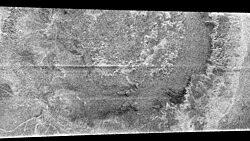 Cassini view of a portion of Menrva, taken on February 15, 2005 | |
| Feature type | Impact crater |
|---|---|
| Coordinates | 20°06′N87°12′W / 20.1°N 87.2°W |
| Diameter | 392 km [1] |
| Eponym | Menrva |
Menrva is the largest crater on Titan, with a diameter of 392 kilometers. [1] The crater is a heavily eroded double ringed impact basin, similar to the impact related features of Mars and Mercury. [2] This is evident by Menrva's distinct lack of a central peak, indicating modification of the crater's surface since formation. [3] It has been estimated that Menrva is approximately 2.8 kilometers deep.
A network of channels known as Elivagar Flumina flow away from the crest of the crater into a catchment basin. [4]
The feature is named after the goddess of wisdom in Etruscan mythology, Menrva. [1]
